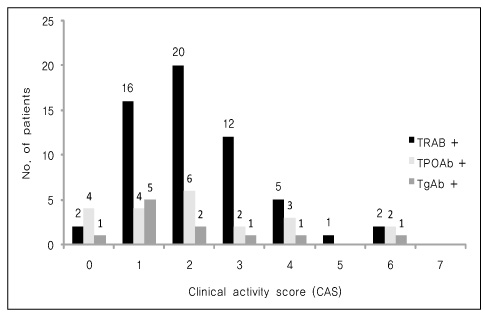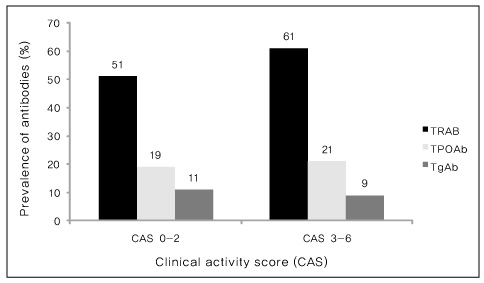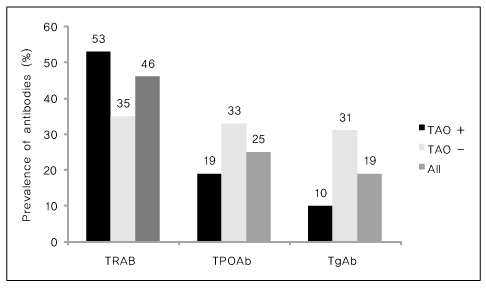J Korean Ophthalmol Soc.
2010 Sep;51(9):1167-1173. 10.3341/jkos.2010.51.9.1167.
Association Between Thyroid Associated Ophthalmopath and Thyroid Autoantibody
- Affiliations
-
- 1Department of Ophthalmology, Hallym University Sacred Heart Hospital, Anyang, Korea. bonamd@paran.com
- KMID: 2122281
- DOI: http://doi.org/10.3341/jkos.2010.51.9.1167
Abstract
- PURPOSE
The same autoimmune process is thought to cause thyroid associated ophthalmopathy (TAO) and Graves' disease. The aim of this study is to determine hether thyroid autoantibody is related to the development of thyroid associated ophthalmopathy.
METHODS
A retrospective chart analysis was performed on patients with a newly diagnosed Graves' disease, who presented to our ophthalmology clinic between January 2006 and December 2009. Thyroid autoantibody titers were obtained at the time of diagnosis and were used to determine the presence or absence of TAO. In addition, any correlations between thyroid autoantibodies were analyzed in patients with TAO.
RESULTS
Thyroid autoantibody levels correlated with the development of TAO. Fifty-eight (69%) out of 84 patients with positive thyroid-stimulating hormone receptor antibody (TRAB) levels at the time of diagnosis had TAO. Only 50 (51%) of the 99 patients with negative TRAB levels had TAO. This difference between the two groups was statistically significant (odds ratio, OR=2.2, p=0.013). A statistically significant correlation with the development of TAO was also found in thyroid peroxidase antibody (TPOAb) and anti-thyroglobulin antibody (TgAb), respectively (OR=0.5, p=0.317; OR=0.3, p=<0.001). In patients with TAO, the correlation between TPOAb and TgAb levels was very high (r=0.64, p=<0.001).
CONCLUSIONS
A significant association was determined to exist between the development of TAO and thyroid autoantibody level. This result demonstrates the clinical utility of thyroid autoantibody for the diagnosis of TAO in patients with newly diagnosed Graves' disease.
Keyword
MeSH Terms
Figure
Cited by 1 articles
-
Clinical Features of Dry Eye in Thyroid-Associated Ophthalmopathy According to Disease Activity
Jun Young Ha, Won Choi, Kyung Chul Yoon
J Korean Ophthalmol Soc. 2016;57(7):1037-1043. doi: 10.3341/jkos.2016.57.7.1037.
Reference
-
1. Feliciello A, Porcellini A, Ciullo I, et al. Expression of thyrotropinreceptor mRNA in healthy and Graves' disease retro-orbital tissue. Lancet. 1993. 342:337–338.2. Heufelder AE, Dutton CM, Sarkar G, et al. Detection of TSH receptor RNA in cultured fibroblasts from patients with Graves' ophthalmopathy and pretibial dermopathy. Thyroid. 1993. 3:297–300.3. Ludgate M, Crisp M, Lane C, et al. The thyrotropin receptor in thyroid eye disease. Thyroid. 1998. 8:411–413.4. Marinò M, Lisi S, Pinchera A, et al. Identification of thyroglobulin in orbital tissues of patients with thyroid-associated ophthalmopathy. Thyroid. 2001. 11:177–185.5. Lisi S, Marinò M, Pinchera A, et al. Thyroglobulin in orbital tissues from patients with thyroid-associated ophthalmopathy: predominant localization in fibroadipose tissue. Thyroid. 2002. 12:351–360.6. Khoo DH, Ho SC, Seah LL, et al. The combination of absent thyroid peroxidase antibodies and high thyroid-stimulating immunoglobulin levels in Graves' disease identifies a Group at markedly increased risk of ophthalmopathy. Thyroid. 1999. 9:1175–1180.7. Gerding MN, van der Meer JW, Broenink M, et al. Association of thyrotrophin receptor antibodies with the clinical features of Graves' ophthalmopathy. Clin Endocrinol. 2000. 52:267–271.8. Konishi J, Herman MM, Kriss JP. Binding of thyroglobulin and thyroglobulin-antithyroglobulin immune complex to extraocular muscle membrane. Endocrinology. 1974. 95:434–446.9. Rhim WI, Choi SS, Lew H, Yun YS. Correlation between the thyroid associated ophthalmopathy and thyroid function state. J Korean Ophthalmol Soc. 2002. 43:431–436.10. Southgate K, Creagh F, Teece M, et al. A receptor assay for the measurement of TSH receptor antibodies in unextracted serum. Clin Endocrinol. 1984. 20:539–548.11. Dolman PJ, Rootman J. VISA Classification for Graves orbitopathy. Ophthal Plast Reconstr Surg. 2006. 22:319–324.12. Woo KI, Kim YD, Lee SY, et al. The Clinical Characteristics of Thyroid Orbitopathy in Thyroid Dysfunction Patients in Korea. J Korean Ophthalmol Soc. 2008. 49:1387–1396.13. Mourits MP, Prummel MF, Wiersinga WM, Koornneef L. Clinical activity score as a guide in the management of patients with Graves' ophthalmopathy. Clin Endocrinol (Oxf). 1997. 47:9–14.14. Park JM, Ahn HB, Lee JH. The clinical features and the change of extraocular muscle at the first visit in hyperthyroidism patients. J Korean Ophthalmol Soc. 2003. 44:2197–2203.15. Rhee KC. The clinical study on Graves' ophthalmopathy. J Korean Ophthalmol Soc. 1996. 40:2923–2927.16. Bartley GB, Fatourechi V, Kadrmas EF, et al. Clinical features of Graves' ophthalmopathy in an incidence cohort. Am J Ophthalmol. 1996. 121:284–290.17. Gupta MK. Thyrotropin receptor antibodies: advances and importance of detection techniques in thyroid diseases. Clin Biochem. 1992. 25:193–199.18. Orgiazzi J. Anti-TSH receptor antibodies in clinical practice. Endocrinol Metab Clin North Am. 2000. 29:339–355.19. Lissak B, Tazartes M, Heron E, Feldman S. Thyroid orbital pathologies in ophthalmological settings. Presse Med. 2002. 31:64–68.20. Goh SY, Ho SV, Seah LL, et al. Thyroid autoantibody profiles in ophthalmic dominant and thyroid dominant Graves' disease differ and suggest ophthalmopathy is a multiantigenic disease. Clin Endocrinol (Oxf). 2004. 60:600–607.21. Eckstein AK, Plicht M, Lax H, et al. Clinical results of anti-inflammatory therapy in Graves' ophthalmopathy and association with thyroidal autoantibodies. Clin Endocrinol (Oxf). 2004. 61:612–618.
- Full Text Links
- Actions
-
Cited
- CITED
-
- Close
- Share
- Similar articles
-
- Prognostic Significance of Thyroid Autoantibodies in Urticaria
- Preoperative Staging of Well Differentiated Thyroid Cancer: US Is Enough?
- Giant Thyroid Cancer in Elderly Patient
- Clinical Follow-up of Children and Adolescents with Hashimoto's Thyroiditis and Hashitoxicosis
- A Case of Killian-Jamieson Diverticulum Mimicking a Thyroid Nodule




